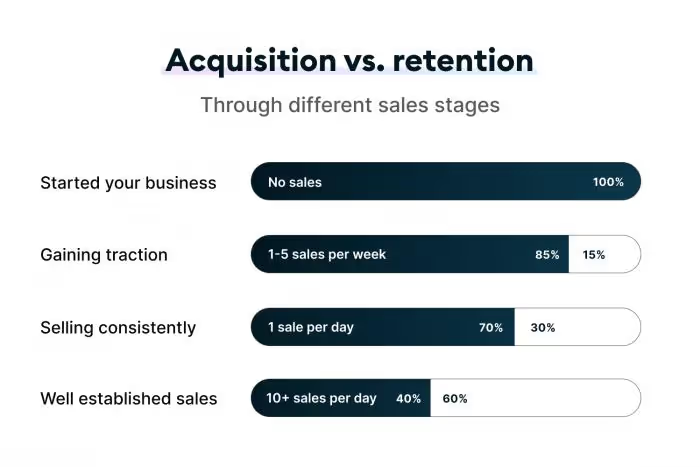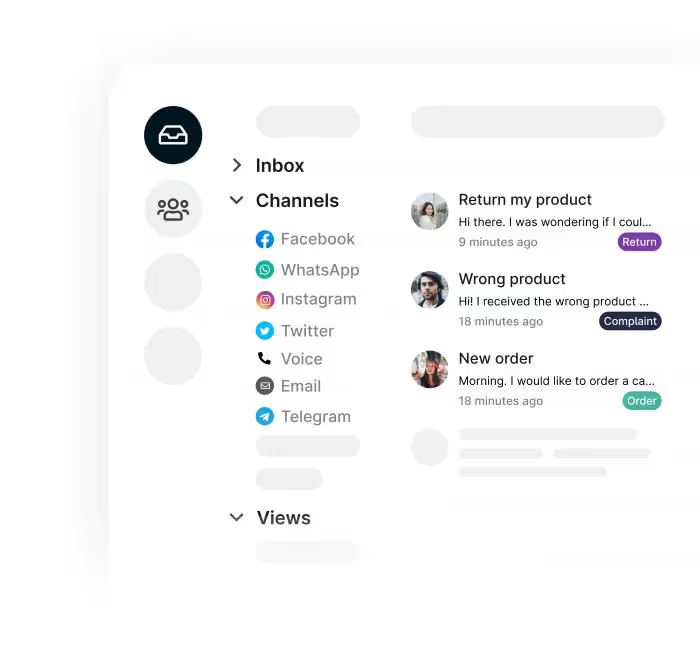When it comes to growing your business, it's easy to get stuck in tunnel vision. You hire more salespeople and double down on your ad spend. You look at traffic, bounce rates, and conversion rates when analyzing your data. Every move you make is centered around one thing: finding new customers.
While that tunnel you're speeding through may feel like an obvious path to success, it's actually a neverending street. With a current world population of 7.8 billion people, you'll always be able to find more customers somewhere. But at some point, you have to switch your focus from finding new customers to actually keeping them on board.
You've probably heard it before: it's cheaper to get an existing customer to buy something than find a new customer. Besides that, there is a way bigger likelihood that an existing customer will turn into a repeat buyer than a lead will turn into a first-time customer.
That's where one of the biggest blind spots in modern business comes in: customer retention.
What is customer retention?
Customer retention is your business' ability to turn one-time customers into repeat buyers and prevent them from switching to the competition. Customer retention is essential to any business because it shows how successful they are at making their customers happy. A business that knows how to acquire customers, but not how to keep them happy, is headed for trouble.
When to start focusing on customer retention
There is a time and place for both customer acquisition and customer retention. This definitely isn't the same for every business. It depends heavily on where your business is in its lifecycle. When you are just starting off and barely have any customers, you obviously need to aim for new customers, since there are no existing ones to attend to. But the more you grow, the more your retention strategy should come into play.

The further you grow, the more retention tactics you start to adopt. Then, once you are fully established and have enough eggs in your basket, retention should start getting more of your attention than acquisition.
Another important aspect is the type of business you run. When you sell cars, retention is less valuable. You can pull out every rabbit in your hat, but your customers will still only buy a car every 5 to 10 years. You can focus some attention on retention in that case, but very minimal. On the other hand, if you sell clothing, food, or anything else with a higher purchase frequency, customer retention obviously becomes a whole lot more valuable.
How to measure your customer retention rate
Your customer retention rate tells you exactly how many customers were retained at the end of a specific period, without counting your new customers. To calculate this, you need to dig up the following information first:
S: The number of customers at the start of a given period
E: The number of customers at the end of that period
N: The number of new customers acquired during that period
When you have collected this information, it's time to grab your calculator to enter the following formula:
((E-N)/S) x 100 = customer retention rate
A good retention rate is 100 (you didn't lose any customers), a terrible retention rate is 0 (you lost all of your customers).
If you're looking to benchmark your retention, you can do this in two ways: against yourself and against other companies.
More customer retention metrics to keep a close eye on
Many businesses tend to focus on a limited number of metrics, and metrics focused on retention aren't always among them. Besides customer retention rate, there are a couple of other interesting ones to add to your dashboard.
Repeat customer rate
'Repeat customer rate' is an obvious first in this list. With this metric, you measure how many of the sales you made are repeat purchases. In order to get a realistic view, make sure to look at longer periods of time. The repeat customer rate of a week's time isn't going to tell you much unless you have a very high number of unique customers.
The formula is straightforward:
number of customers that made a repeat purchase/number of unique customers = repeat customer rate
Churn rate
The churn rate is the rate at which customers stop buying from your business over a set period of time. The lower this rate, the more customers are staying loyal to you. The higher the churn rate, the more customers are leaving you for your competitors. So we obviously want a churn rate that is as low as possible.
This is the formula:
(customers at the beginning of the time period - customers at the end of the time period)/customers at the beginning of the time period
Purchase frequency
Another valuable metric to take keep your eye on is purchase frequency. This measures the number of times your average customer buys from your business in a given period. It's especially interesting to focus on this metric when you sell a product that actually has the potential of generating a high average purchase frequency.
The formula:
Number of customers who bought more than once in a set period of time / total number of customers in a set period of time
Examples of customer retention strategies
Now, let's get into the good stuff. There are many different ways to retain your customers. Here a couple of good examples to get started.
1. Customer loyalty program
One of the oldest tricks in the book is a customer loyalty program. This is where you recognize and award customers who regularly buy from your business. The more the customer buys, the more perks they get. In turn, this motivates the customer to buy even more regularly.
There are many different forms of rewards, but a well-known example is the Starbucks Rewards program. By ordering a coffee through their app, you collect points that will eventually get you a free coffee. There are many other businesses that have started using these types of apps now.
For the customer, installing the app and actually using it is quite a big step. But once the customer starts collecting, he's inclined to stay with you for quite some time.
2. Email marketing
A simple and obvious way to retain customers is by sending out a regular newsletter. You can send out a standardized email to your entire customer base. Include the latest news, upcoming products, and special deals. Make sure the newsletter contains enough value for the customer so that they will keep opening them when they receive them.
Besides sending out a newsletter, you can also send personalized emails to your customers. For instance, if a customer has been with you for a long time and has stopped purchasing, it makes sense to get in contact. This is a more difficult process that requires a lot of automation to be in place unless you have a low number of customers. However, when it is in place, you won't regret the effort it took.
3. Great customer support
A great way to keep customers on board, or even turn them into brand ambassadors, is by offering top-notch support. In order to deliver fast and high-quality support without putting efficiency on the backburner, teams need to use the right tools. Imagine you have all these different channels to communicate with your customers. From email, voice, and live chat to WhatsApp, Messenger, and Google Business Messages.

If you have to monitor all these channels individually you're not going to be able to provide a good experience — without losing your mind that is. That's why teams should work collectively in one team inbox that collects all their communication channels in one overview. This makes their lives way easier. They can work together on conversations and automate repetitive tasks with chatbots.
4. Onboarding program
The following customer retention strategy is usually performed by customer success professionals: an onboarding program. With this, your team can teach new customers everything they need to know to get started with your product or service. The customer success employee personalizes each training to the needs of the customer. This is obviously a time-consuming investment, so be sure to only opt for this strategy when it's truly worth it. An industry where onboarding is usually done a lot is SaaS.
5. Customer education program
You can take it a step further and offer complete customer education programs to your customers. You can do this by creating a dense Help Center with articles about the ins and outs of your product. This gives your customers the opportunity to take a deep dive into your product without having to consult a support employee, creating a better and longer-lasting customer experience.
An excellent example of a business that knows what they're doing in this area is Webflow. They have created a fantastic source of blog articles, help center articles, and YouTube videos that teach you everything you need to know about their product. Since their product is based around web design, they also get into how to start a freelancing career, for example. By offering their customers content that isn't directly related to their product, they create a strong relationship that garners loyalty.
6. Thank you cards
Even though we're knee-deep in the digital age, there's still nothing that beats tangible gifts. It's nice to get a text message for your birthday, but you're not hanging it on your fridge like you would with a birthday card. A handwritten thank you card shows your customers how much you care about them, simply because the effort that was taken can't be automated or faked. And real effort will always be appreciated.
7. Social proof
Social proof is known to be used by businesses to persuade prospects to pick them over the competition. What people tend to forget, is that customer stories can also be of value to the existing customer base. At Trengo, for instance, we also send customer stories to our own customers. In those stories, our customers share creative ways in which they are using our product, which has many different features. This can inspire our existing customers to get deeper into our product as well.
Further reading
That was a short introduction to customer retention. Want to learn more about turning one-time customers into loyal supporters? Check out our whitepaper on e-commerce customer service in 2021.




.png)











